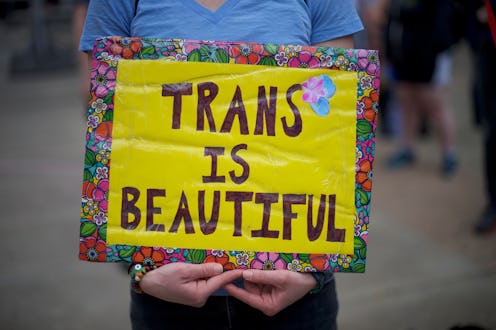Life
These LGBTQ Teens Are The Most Vulnerable

Last year was a difficult time for transgender rights, and 2017 doesn't appear to be any better so far. In addition to last week's White House rollback of protections for transgender students with regards to bathroom access, a recent study from the University of California, Berkeley has found that transgender and genderfluid teenagers face far more abuse at school and at home than their cisgender peers — even those who identify as LGBQ.
In the study, published in the journal Child Abuse & Neglect, researchers collected data from nearly 1,200 LGBTQ adolescents between 14 and 19 years old. Among other topics, participants were asked about their socioeconomic status, mental health, and experiences with different types of violence such as bullying and sexual assault. Experiences with violence were common across the board; school-based bullying was reported by almost 70 percent of all respondents, and approximately 40 percent had gone through 10 or more types of violence within the last year. These respondents were classified as polyvictims — those who experienced multiple forms of victimization. However, researchers found marked differences in the types of violence experienced by different groups.
Transgender and genderfluid teens were at the greatest risk overall for becoming polyvictims, experiencing multiple kinds of violence at home, school, in the general community, and online. Cyberbullying was most common among male-to-female transgender students; genderfluid teens who were assigned male at birth were more likely to be victims of sexual violence. In fact, according to Science Daily, researchers described transgender and genderfluid teens who were assigned male at birth as the "most vulnerable subgroup" in the study, especially compared to cisgender sexual minority boys.
Researchers identified several risk factors for polyvictimization, including peer rejection and family-level microaggressions (everyday slights that combine to paint a larger picture of discrimination). As far as LGBTQ rights have come, too many LGBTQ teens still experience family rejection. According to a 2012 report on homeless youth, 68 percent of homeless LGBTQ clients in housing programs had been spurned by their families, and there's evidence that such rejection is the primary cause of the high rates of homeless LGBTQ youth.
Unfortunately, school environments aren't much better for LGBTQ teens. According to the Centers for Disease Control (CDC), LGBTQ youth are at a higher risk than their heterosexual peers for bullying and substance abuse, and they're more likely to feel unsafe at school due to their orientation or gender identity.
As the UC Berkeley study shows, the risk for violence varies even within the LGBTQ community. Transgender rights have been particularly targeted by politicians over the last year, culminating in the recent attempts to roll back Obama-era protections of bathroom access for transgender students.
The LGBTQ community, especially its youngest members, remains vulnerable to violence even in 2017, and if the current state of LGBTQ rights is any indication, there's still a long way to go before it's protected. Here are some things to do to help, and some places to donate your time, skills, or money if you can.